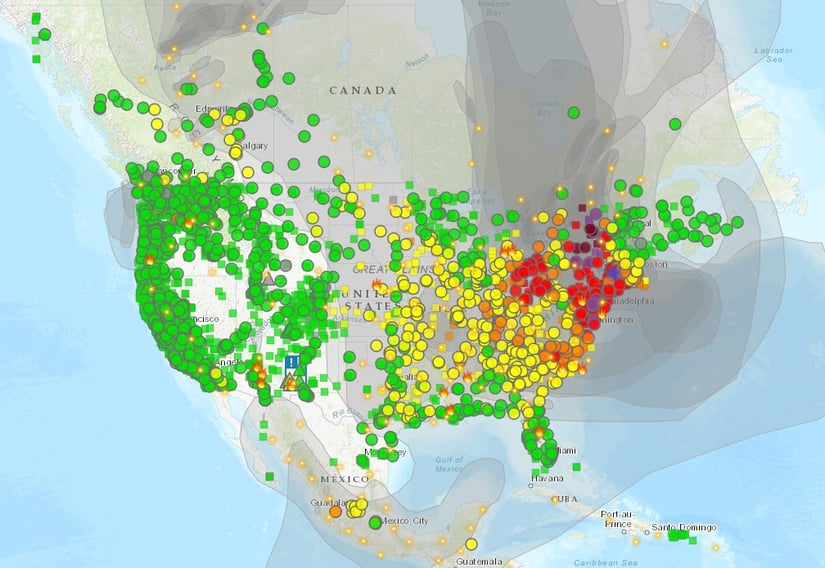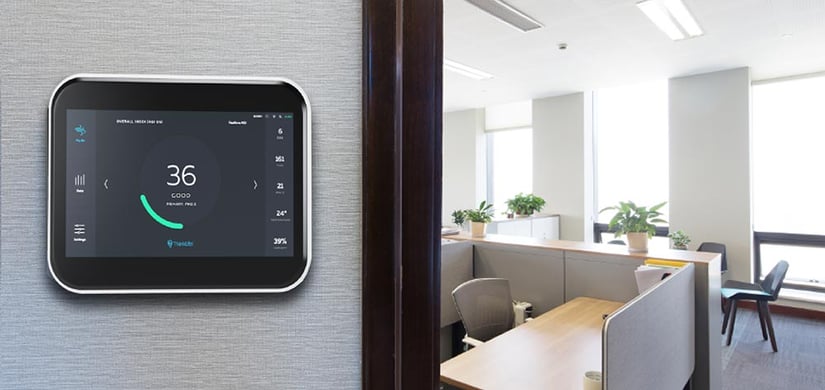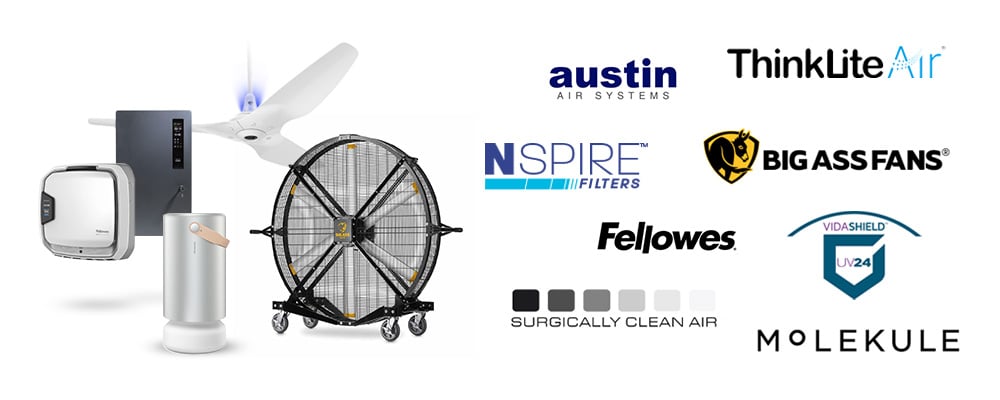How to Protect Yourself From Wildfire Smoke
In this post:
- What's wildfire smoke, and why is it dangerous?
- Ways to protect yourself if wildfire smoke is affecting your area
- Solutions to improve your indoor air quality for healthier air
 AirNow Real-Time Fire and Smoke Map, June 2023
AirNow Real-Time Fire and Smoke Map, June 2023
Many areas around the country have been experiencing poor air quality due to wildfire smoke. Whether that's from recent Canadian wildfires or what we've experienced each late summer and fall from longer-than-usual hot and dry spells (that have only gotten worse in the last few years) and average temperatures continuously on the rise in drought-ravaged Western states, these volatile wildfires burn hotter and for longer, threatening homes, diminishing air quality, and creating health hazards.
Recent studies have shown that being exposed to both higher temperatures and wildfire smoke at the same time can worsen the health risks, and that's expected to become more of a threat, UCLA researchers said in a study published in 2022.
"Rising global temperatures and more frequent extreme heat events are expected to increase wildfire size and intensity, signaling a growing public health threat from concurrent heat-smoke exposure," researchers wrote.
What's in Wildfire Smoke, Anyway?
Wildfire smoke contains two types of air pollution: gaseous pollutants and particulate matter. Gases found in wildfire smoke include carbon monoxide, ozone, and volatile organic compounds (VOCs). While you tend to witness the larger particles as they are the most visible in the air, it's the smaller particles and gases that can travel further from the fire source and have more impactful effects on our health.
Particle pollution includes both solid particles and liquid droplets, most of which are too small to be seen by the naked eye. Particle size is measured in microns (which is one ten-thousandth of a centimeter). The majority of particles in wildfire smoke fall into the category of “fine particles” measuring 2.5 microns or less, and at that size, these fine particles are those that cause health issues.
Fine particles and ultra-fine particles (smaller than 0.1 microns) are small enough to get deep into your respiratory system. Short-term exposure to particles in wildfire smoke can cause irritation as your body tries to protect you from the pollutants. Symptoms can include runny nose, burning eyes, coughing, wheezing and respiratory illnesses such as bronchitis. Exposure to wildfire smoke has also been linked to an increased risk of allergies and asthma. The particles in smoke can also worsen symptoms of existing heart and lung conditions
While the majority of wildfire smoke results from trees and brush that are burning, wildfire has a life of its own, and can quickly burn everything else in its path (cars, homes, etc.). The chemicals contained in these items also burn, producing harmful VOCs and toxic gases. Communities experiencing wildfires in their area may be at greater risk of exposure to toxic VOCs and ozone, which are far more likely to be absorbed by the lungs and end up in the blood than larger particles that can be filtered out by the body’s natural defenses.
Per the EPA, the following groups are at the greatest health risk from wildfire smoke:
- Those who have cardiovascular or respiratory diseases
- Older adults
- Children under 18
- Pregnant women
- People who work outside
How to Keep Yourself Safe: Monitor The Air
Check your air quality outside daily. By staying current on the level of smoke and other pollution in your region, you can make informed choices to decrease your exposure to harmful pollutants. Whether you live in an area where wildfires are common or one that is prone to traveling smoke (even if a wildfire is hundreds of miles away, it can still impact your air quality). checking the air quality in your area should be a part of your daily routine.
For outside air quality, AirNow.gov is a free resource provided by the EPA that assigns Air Quality Index (AQI) numbers to describe the current level of air pollution. The real-time air quality map from PurpleAir can also help you determine the current level of air pollution where you live, plus check your local news station, or National Weather Service. Bear in mind that different places use different kinds of sensors to collect their air quality information. Also, some sites provide real-time data, while others use a rolling average of air quality measurements.
Monitor & Maintain Indoor Air Quality
 Even with your doors and windows closed, it is still possible for smoke to make its way inside, plus there're everyday sources of indoor air pollution (candles, frying food, even vacuuming) affecting your indoor air quality. To keep track of the state of the air in your home, consider an indoor air quality monitor.
Even with your doors and windows closed, it is still possible for smoke to make its way inside, plus there're everyday sources of indoor air pollution (candles, frying food, even vacuuming) affecting your indoor air quality. To keep track of the state of the air in your home, consider an indoor air quality monitor.
Use an HVAC filter with a MERV rating of 13 and air purifier to remove some of the pollution present in your indoor air.
If you use an air purifier to help clean the air in your home, look for one rated to handle your specific room size. It’s also worth noting that only certain filters can handle both the particulate matter and certain gaseous pollutants (such as VOCs) present in wildfire smoke. For example, the PECO technology found in Molekule air purifiers can trap and destroy organic pollutants, including both particulate matter and VOCs.
Note: If you live in an area prone to wildfires, you may want to stock up on extra air purifier and HVAC filters before a fire breaks out.

Reduce Outdoor Smoke Exposure
If wildfire smoke is affecting your outdoor air quality, limit the amount of time you spend outside. Activities such as walking, hiking, or just mowing your lawn can expose you to harmful gases and VOCs. Try to keep enough food and medicine on hand to avoid unnecessary trips out. if you must go out, wear an N95 respirator mask that can filter out harmful particles.
If you have to go out, make sure to keep the windows rolled up in your car and set your car air conditioner to recirculate mode to decrease the amount of outdoor air entering your vehicle. As always, stay alert for any public service announcements, air quality advisories, or health advisories from local authorities.
Protect Your Home From Wildfire Smoke
According to the EPA, indoor air is often more polluted than outdoor air, even in large cities. During wildfire season it is a good idea to decrease the amount of outdoor air that enters your home in an effort to minimize the presence of smoke in the house. If possible, retrofit windows, install new weather stripping around door frames and use tape or plastic to seal any cracks where outdoor air may enter your home. However- make sure that the measures you take will not make it difficult to leave your home quickly in emergencies -safety first, always!
By taking steps to be aware of your air quality, improve your indoor air and minimize your smoke exposure and weatherproof your home from outdoor air, you can help protect your health during wildfire season.
Related Posts:
We approach IAQ from a whole-facility perspective, with the goal of not only reducing contaminants in the air but also improving the comfort level of building occupants through air quality improvements.
Topics from this blog: Product Resources
Back


